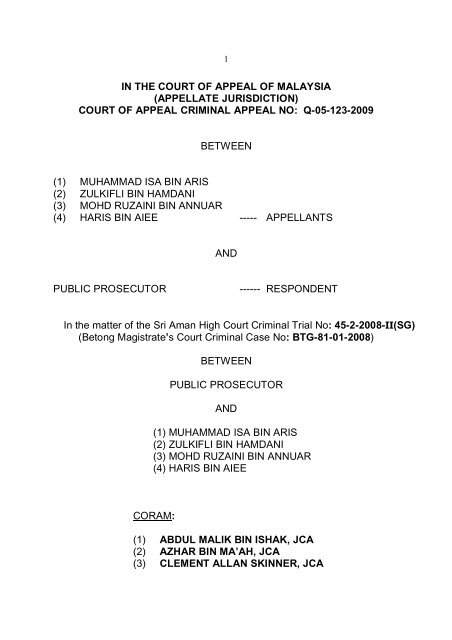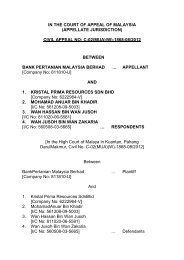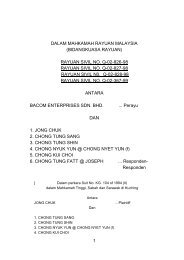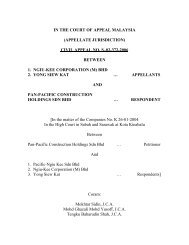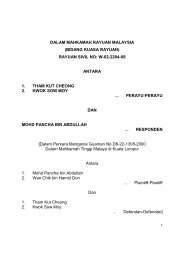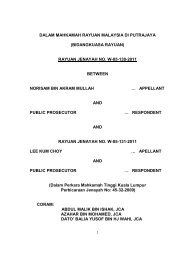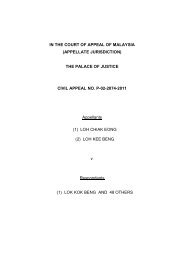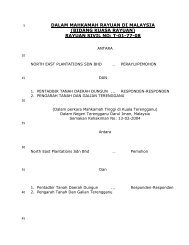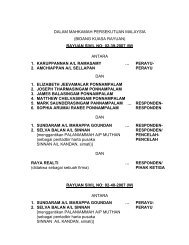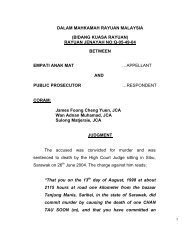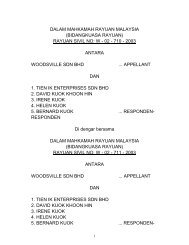court of appeal criminal appeal no: q-05-123-2009 between
court of appeal criminal appeal no: q-05-123-2009 between
court of appeal criminal appeal no: q-05-123-2009 between
You also want an ePaper? Increase the reach of your titles
YUMPU automatically turns print PDFs into web optimized ePapers that Google loves.
1<br />
IN THE COURT OF APPEAL OF MALAYSIA<br />
(APPELLATE JURISDICTION)<br />
COURT OF APPEAL CRIMINAL APPEAL NO: Q-<strong>05</strong>-<strong>123</strong>-<strong>2009</strong><br />
BETWEEN<br />
(1) MUHAMMAD ISA BIN ARIS<br />
(2) ZULKIFLI BIN HAMDANI<br />
(3) MOHD RUZAINI BIN ANNUAR<br />
(4) HARIS BIN AIEE ----- APPELLANTS<br />
AND<br />
PUBLIC PROSECUTOR ------ RESPONDENT<br />
In the matter <strong>of</strong> the Sri Aman High Court Criminal Trial No: 45-2-2008-II(SG)<br />
(Betong Magistrate’s Court Criminal Case No: BTG-81-01-2008)<br />
BETWEEN<br />
PUBLIC PROSECUTOR<br />
AND<br />
(1) MUHAMMAD ISA BIN ARIS<br />
(2) ZULKIFLI BIN HAMDANI<br />
(3) MOHD RUZAINI BIN ANNUAR<br />
(4) HARIS BIN AIEE<br />
CORAM:<br />
(1) ABDUL MALIK BIN ISHAK, JCA<br />
(2) AZHAR BIN MA’AH, JCA<br />
(3) CLEMENT ALLAN SKINNER, JCA
Introduction<br />
2<br />
ABDUL MALIK BIN ISHAK, JCA<br />
DELIVERING THE JUDGMENT OF THE COURT<br />
[1] Initially, all the four appellants were jointly charged for an <strong>of</strong>fence<br />
<strong>of</strong> murder under section 302 <strong>of</strong> the Penal Code read together with section<br />
34 <strong>of</strong> the same Code and if they were found guilty they would be sentenced<br />
to death. They were quite lucky. The prosecution decided to reduce the<br />
charge. An amended charge under section 304(a) <strong>of</strong> the Penal Code read<br />
with section 34 <strong>of</strong> the same Code was tendered. By this amended charge,<br />
the appellants were jointly charged for committing culpable homicide <strong>no</strong>t<br />
amounting to murder by causing the death <strong>of</strong> Kaderi bin Noh on 18.4.2008<br />
at about 11.00 p.m. in front <strong>of</strong> the mosque at Kampung Tengah Beladin,<br />
Pusa, in the district <strong>of</strong> Sri Aman, Sarawak.<br />
[2] All the four appellants pleaded guilty to the amended charge and<br />
the learned Judicial Commissioner (“JC”) convicted and sentenced them<br />
accordingly. In regard to the first, third and fourth appellants, the learned<br />
JC sentenced each <strong>of</strong> them to 18 years imprisonment with effect from<br />
the date <strong>of</strong> their arrest and that was on 19.4.2008. In regard to the second<br />
appellant, a child <strong>of</strong>fender, the learned JC sentenced him to 10 years<br />
imprisonment with effect from the date <strong>of</strong> his arrest and that was on
3<br />
19.4.2008 and her Ladyship also ordered that the second appellant be<br />
segregated from the adult prisoners pursuant to section 96(3) <strong>of</strong> the Child<br />
Act 2001 (Act 611).<br />
[3] Aggrieved by the sentences imposed on them, all the four<br />
appellants <strong>appeal</strong>ed to this <strong>court</strong>. They complained that the sentences<br />
were grossly excessive.<br />
[4] We anxiously heard their <strong>appeal</strong>s and we substituted their<br />
sentences in this manner. In regard to the first, third and fourth appellants,<br />
we sentenced each <strong>of</strong> them to 15 years imprisonment with effect from<br />
the date <strong>of</strong> their arrest and that would be on 19.4.2008. And in regard to<br />
the second appellant, a child <strong>of</strong>fender, we sentenced him to 8 years<br />
imprisonment from the date <strong>of</strong> his arrest and that would be on 19.4.2008.<br />
We also made an order that the second appellant being a child <strong>of</strong>fender be<br />
segregated from the other adult prisoners by virtue <strong>of</strong> section 96(3) <strong>of</strong> the<br />
Child Act 2001 (Act 611).<br />
[5] It is apparent that we have reduced their sentences to suit the<br />
facts and circumstances <strong>of</strong> the case and after carefully considering the<br />
principles <strong>of</strong> sentencing relevant to the four appellants. We shall say more<br />
about this later. They are still unhappy with the sentences meted out by us.<br />
They are <strong>no</strong>w <strong>appeal</strong>ing to the Federal Court (for the first appellant,<br />
Muhammad Isa bin Aris, Federal Court <strong>criminal</strong> case <strong>no</strong>: <strong>05</strong>-159-2010(Q)
4<br />
and for the third appellant, Mohd Ruzaini bin Annuar, Federal Court<br />
<strong>criminal</strong> case <strong>no</strong>: <strong>05</strong>-160-2010(Q)).<br />
The factual matrix<br />
[6] On that fateful night, the deceased and two <strong>of</strong> his friends were<br />
on their way home after they had their drinks at the wharf at Kampung<br />
Hulu. They took a short cut via Kampung Tengah Beladin in order to<br />
return home at Kampung Hilir.<br />
[7] On arrival at Kampung Tengah Beladin, they were surrounded<br />
by the four appellants who were armed with a piece <strong>of</strong> wood each. The<br />
four appellants then chased the deceased and his two friends. The<br />
deceased’s two friends managed to reach home safely.<br />
[8] But, unfortunately, the deceased could <strong>no</strong>t escape and he was<br />
mercilessly beaten by all the four appellants. The first appellant used a<br />
piece <strong>of</strong> wood to hit the back portion <strong>of</strong> the deceased while the second<br />
appellant, a child <strong>of</strong>fender, bashed the deceased’s head with a piece <strong>of</strong><br />
wood. A short while later, the third and the fourth appellants joined in the<br />
affray and they each assaulted the deceased with a piece <strong>of</strong> wood which<br />
they carried separately. Using a piece <strong>of</strong> wood, the third appellant<br />
whacked the back torso <strong>of</strong> the deceased. The fourth appellant too<br />
assaulted the deceased on the same spot with a piece <strong>of</strong> wood and he<br />
too kicked the deceased.
5<br />
[9] Investigations revealed that all the four appellants had<br />
consumed alcohol and they were involved in a gang fight and that they<br />
were under the impression that the deceased was from a rival gang who<br />
had attacked them earlier on. Investigations also revealed that all the four<br />
appellants had pursued the deceased and had mercilessly beaten him to<br />
death. The pathologist confirmed that the cause <strong>of</strong> death was due to the<br />
blunt force trauma on the deceased’s head.<br />
The reasons for the reduced sentences<br />
[10] We have deliberated at great length and we have reduced their<br />
sentences. We took into consideration the following factors:<br />
(a) that the original charge <strong>of</strong> murder was reduced by the<br />
prosecution to a charge <strong>of</strong> culpable homicide <strong>no</strong>t amounting to<br />
murder and on this reduced charge they pleaded guilty<br />
(Melvani v. Public Prosecutor [1971] 1 MLJ 137) thereby<br />
saving precious time and costs bearing in mind that the<br />
prosecution had indicated that they would call approximately 20<br />
witnesses and the defence would call approximately 7 witnesses<br />
(see page 9 <strong>of</strong> the <strong>appeal</strong> record);<br />
(b) that they were all first <strong>of</strong>fenders with clean records (Public<br />
Prosecutor v. Jafa bin Daud [1981] 1 MLJ 315);
6<br />
(c) that at the time <strong>of</strong> the commission <strong>of</strong> the <strong>of</strong>fence, their ages<br />
were in this order;<br />
(i) the first appellant was 18 years 6 months and 3 days old;<br />
(ii) the second appellant, a child <strong>of</strong>fender, was 16 years 11<br />
months and 27 days old;<br />
(iii) the third appellant was 19 years 6 months and 21 days<br />
old; and<br />
(iv) the fourth appellant was 23 years 3 months and 8 days<br />
old.<br />
(d) that they all came from poor family backgrounds and had <strong>no</strong><br />
proper education:<br />
(i) the first appellant attended school up to primary six at<br />
Sekolah Kebangsaan Beladin;<br />
(ii) the second appellant, a child <strong>of</strong>fender, did <strong>no</strong>t go to school<br />
at all;<br />
(iii) the third appellant attended school up to Form 5 at<br />
Sekolah Menengah Kebangsaan Santubong; and<br />
(iv) the fourth appellant attended school up to primary six at<br />
Sekolah Kebangsaan Beladin.<br />
[11] We also considered the probation reports prepared by Encik<br />
Norazman bin Abdul Rahim from the welfare <strong>of</strong>fice at Kuching, Sarawak
7<br />
dated 14.5.<strong>2009</strong>. The probation reports on all the four appellants indicated<br />
that they were fishermen by pr<strong>of</strong>ession and that their incomes were <strong>no</strong>t<br />
fixed and dependent on the “catch” <strong>of</strong> the day.<br />
[12] We also took into account the fact that all the four appellants<br />
had cooperated with the police ever since they were arrested on 19.4.2008<br />
and this greatly assisted the police to complete their investigations<br />
expeditiously.<br />
[13] We were at pains to consider the mitigation advanced by<br />
learned counsel on behalf <strong>of</strong> the four appellants. We <strong>no</strong>ted that:<br />
(a) they have learnt a bitter lesson;<br />
(b) they have caused hardship to their parents and other family<br />
members;<br />
(c) they have also caused hardship and pain to the deceased’s<br />
parents and members <strong>of</strong> the deceased’s family;<br />
(d) they regretted for what they had done and they are desirous <strong>of</strong><br />
turning over a new leaf and lead <strong>no</strong>rmal lives after undergoing<br />
their prison terms; and<br />
(e) they had <strong>no</strong> intention to kill the deceased but they merely<br />
intended to cause injury.<br />
[14] It is said that the degree <strong>of</strong> culpability for each <strong>of</strong> the four<br />
appellants should be different and that there should be a disparity in the
8<br />
sentences (Public Prosecutor v Tan Chee Seng & Ors [2004] 1 MLJ<br />
392). Here, on the facts, it was the second appellant – the child <strong>of</strong>fender,<br />
who bashed the deceased’s head with a piece <strong>of</strong> wood. And the injury to<br />
the head was the cause <strong>of</strong> the death <strong>of</strong> the deceased. Thus, the severity<br />
<strong>of</strong> the sentence should be borne by the second appellant – the child<br />
<strong>of</strong>fender, and <strong>no</strong>t the other three appellants. However, the reduced<br />
charge invoked section 34 <strong>of</strong> the Penal Code. What this amounts to is<br />
this. It is statutorily recognised that if more than two persons intentionally<br />
commit a crime together it is as if each <strong>of</strong> them had committed the crime<br />
individually. It falls squarely within the concept <strong>of</strong> joint liability in<br />
committing the <strong>criminal</strong> <strong>of</strong>fence based on common intention. Thus, an<br />
individual accused person is held to be responsible for the <strong>criminal</strong> acts<br />
done by several persons in furtherance <strong>of</strong> the common intention <strong>of</strong> all<br />
irrespective <strong>of</strong> the role played by each accused person in the perpetration<br />
<strong>of</strong> the <strong>of</strong>fence. It is a question <strong>of</strong> fact in every case in order to determine<br />
the existence <strong>of</strong> common intention. Section 34 <strong>of</strong> the Penal Code would<br />
bite even if the wrongdoer is absent from the scene <strong>of</strong> the crime (Ibrahim<br />
bin Masod & A<strong>no</strong>r v Public Prosecutor [1993] 3 SLR 873, CA).<br />
[15] It is correct to say that in order to invoke section 34 <strong>of</strong> the Penal<br />
Code against all the four appellants, concert pursuant to a pre-arranged<br />
plan has to be established either by way <strong>of</strong> direct evidence or by way <strong>of</strong>
9<br />
inference from the surrounding circumstances and that the <strong>criminal</strong> act<br />
complained <strong>of</strong> must have been done by one <strong>of</strong> the four appellants in<br />
furtherance <strong>of</strong> the common intention <strong>of</strong> them all (Mahbub Shah v. King<br />
Emperor [1945] LR Vol. LXXII Indian Appeals 148; Joginder Singh v.<br />
State <strong>of</strong> Haryana AIR [1994] SC 461; Pandurang and others v. State <strong>of</strong><br />
Hyderabad AIR [1955] SC 216; Kripal and others v State <strong>of</strong> Uttar<br />
Pradesh AIR [1954] SC 706; Lee Yoon Choy & 2 Others v. Public<br />
Prosecutor [1949] 15 MLJ 66; Dato Mokhtar Hashim & A<strong>no</strong>r. v. Public<br />
Prosecutor [1983] 2 MLJ 232, FC, at 265; Isa bin Che Noh & Ors. v.<br />
Public Prosecutor [1956] 22 MLJ 93; Chew Cheng Lye v. Reg. [1956]<br />
22 MLJ 240 at 241; Tansley v Painter [1969] Crim LR 139; R v. Searle<br />
and Others [1971] Crim LR 592, CA; (1) Namasiyiam (2) Rajindran (3)<br />
Goh Chin Peng, and (4) Ng Ah Kiat v. Public Prosecutor [1987] 2 MLJ<br />
336, SC at 344; Kamaruzaman Mat Hassan & A<strong>no</strong>r v. Public<br />
Prosecutor [1997] 5 CLJ 279 at 286; Muhamad Safarudin Baba & A<strong>no</strong>r<br />
v. PP [2002] 4 CLJ 210, CA at 222; and Public Prosecutor v Ayyavoo<br />
a/l Subramaniam & A<strong>no</strong>r [2004] 6 MLJ 511). It is also apt to say that<br />
common intention can also develop on the spur <strong>of</strong> the moment or on the<br />
spot (Krishna Govind Patil v. State <strong>of</strong> Maharashtra AIR [1963] SC 1413;<br />
and Hari Om v. State <strong>of</strong> U P [1993] Cri LJ 1383).
10<br />
[16] Here, all the four appellants played active roles in assaulting<br />
the deceased. They must, in the context <strong>of</strong> section 34 <strong>of</strong> the Penal Code,<br />
be held accountable for the death <strong>of</strong> the deceased. Indeed they have<br />
pleaded guilty to the amended charge <strong>of</strong> culpable homicide <strong>no</strong>t amounting<br />
to murder.<br />
[17] A concerted submission was made on behalf <strong>of</strong> the second<br />
appellant, the child <strong>of</strong>fender, based on the probation report that he<br />
should be sent to the Henry Gurney school until he reaches the age <strong>of</strong> 21<br />
pursuant to section 76 <strong>of</strong> the Child Act 2001 (Act 611). We declined to do<br />
so. Instead we reduced his sentence and we sentenced him to 8 years<br />
imprisonment from the date <strong>of</strong> his arrest (19.4.2008) and we ordered that<br />
he be segregated from the other adult prisoners by virtue <strong>of</strong> section 96(3)<br />
<strong>of</strong> the Child Act 2001 (Act 611). We <strong>no</strong>ted that although the second<br />
appellant is a child <strong>of</strong>fender at the time <strong>of</strong> committing the <strong>of</strong>fence yet it was<br />
he who bashed the deceased’s head with a piece <strong>of</strong> wood. The fatal blow<br />
was delivered by the second appellant – the child <strong>of</strong>fender. The head is a<br />
vital part <strong>of</strong> the human body. Any injury to the head is almost always<br />
disastrous.<br />
[18] It is <strong>no</strong>t easy to sentence an accused person appropriately<br />
benefitting the nature and circumstances <strong>of</strong> the <strong>of</strong>fence. But an accused<br />
person who chooses to commit a crime must be held accountable and be
11<br />
responsible for the resulting evil and he deserves to be punished. The<br />
sentence meted out should adequately reflect the revulsion <strong>of</strong> the citizens<br />
for the particular crime committed. The purpose <strong>of</strong> sentencing is seen <strong>no</strong>t<br />
only as a punishment to the accused person, it is also seen as a public<br />
denunciation <strong>of</strong> the <strong>criminal</strong> act in question.<br />
[19] The sentence meted out must be proportionate to the <strong>of</strong>fence.<br />
It is <strong>of</strong>ten said that the business <strong>of</strong> the <strong>court</strong> is to do justice and this can be<br />
achieved if the sentence is proportionate <strong>between</strong> one <strong>of</strong>fender to that <strong>of</strong><br />
a<strong>no</strong>ther.<br />
[20] Public interest features prominently in sentencing an accused<br />
person. Indeed this is the approach adopted by this <strong>court</strong> in Tan Sri<br />
Abdul Rahim bin Mohd Noor v Public Prosecutor [2001] 4 CLJ 9 at 13,<br />
[2001] 3 AMR 3253 at 3257, [2001] 3 MLJ 1 at 4, where Shaik Daud JCA<br />
had this to say:<br />
“It can<strong>no</strong>t be gainsaid that the most onerous function <strong>of</strong> any <strong>court</strong> is<br />
to decide the appropriate sentence in any <strong>criminal</strong> case. In deciding<br />
the appropriate sentence a <strong>court</strong> should always be guided by certain<br />
considerations. The first and foremost is the public interest. In that<br />
context the interest <strong>of</strong> justice should <strong>no</strong> doubt take into account the<br />
interest <strong>of</strong> the <strong>of</strong>fender. But it is <strong>of</strong>ten forgotten that the interest <strong>of</strong><br />
justice must also include the interest <strong>of</strong> the community. In<br />
assessing sentence the <strong>court</strong> should balance the interest <strong>of</strong> the<br />
<strong>of</strong>fender with the interest <strong>of</strong> the victim and strike a balance, <strong>no</strong>t, <strong>of</strong><br />
course forgetting that the interest <strong>of</strong> the public should be <strong>of</strong> the<br />
uppermost consideration.”
12<br />
[21] What Hilbery J said in Kenneth John Ball [1951] 35 Cr App R<br />
164 is still accepted and adopted as good law. This was what his Lordship<br />
said at page 166:<br />
“Our law does <strong>no</strong>t, therefore, fix the sentence for a particular crime,<br />
but fixes a maximum sentence and leaves it to the Court to decide<br />
what is, within that maximum, the appropriate sentence for each<br />
<strong>criminal</strong> in the particular circumstances <strong>of</strong> each case. Not only in<br />
regard to each crime, but in regard to each <strong>criminal</strong>, the Court has<br />
the right and the duty to decide whether to be lenient or severe.”<br />
[22] And this simple proposition <strong>of</strong> the law has been dutifully<br />
followed in the following cases:<br />
(a) Abu Bakar bin Alif v. R. [1953] 19 MLJ 19;<br />
(b) Public Prosecutor v. Lim Swee Guan [1969] 1 MLJ 84;<br />
(c) Public Prosecutor v. Loo Choon Fatt [1976] 2 MLJ 256;<br />
(d) Public Prosecutor v Nazarudin bin Ahmad & Ors [1993] 2<br />
MLJ 9, [1993] 2 CLJ 543; and<br />
(e) Irwan b Abdullah & 38 Lagi v Pendakwa Raya [2002] 2 AMR<br />
2174, [2002] 3 CLJ 151, [2002] 2 MLJ 577.<br />
[23] A sentence imposed must always relate to the facts and<br />
circumstances <strong>of</strong> the case. The sentencing judge must always take into<br />
account and apply his mind to the factual matrix <strong>of</strong> the case (Abdul Karim<br />
v. Regina; Sundra Singh v. Regina; Loh Kai Hoi v. Regina [1954] 20<br />
MLJ 86).
13<br />
[24] It is ideal to recognise that <strong>no</strong> two cases are alike. And that<br />
the facts must necessarily vary from case to case and, at the end <strong>of</strong> the<br />
day, each case has to be decided on its own merits (Tan Koon Swan v<br />
Public Prosecutor [1986] SLR 126, CA, [1987] 2 MLJ 129 at 130, CCA<br />
(Singapore)).<br />
[25] In Liow Siow Long v. Public Prosecutor [1970] 1 MLJ 40,<br />
Raja Azlan Shah J (as His Royal Highness then was) aptly said at page 42:<br />
“It is <strong>no</strong>t in doubt that the right measure <strong>of</strong> punishment for an<br />
<strong>of</strong>fence is a matter in which <strong>no</strong> hard and fast rules can be laid down<br />
and it is to be determined by a consideration <strong>of</strong> a variety <strong>of</strong><br />
circumstances. In assessing sentence, the primary consideration is<br />
the character and magnitude <strong>of</strong> the <strong>of</strong>fence, but the <strong>court</strong> can<strong>no</strong>t<br />
lose sight <strong>of</strong> the proportion which must be maintained <strong>between</strong> the<br />
<strong>of</strong>fence and the penalty and the extenuating circumstances which<br />
might exist in the case.”<br />
[26] We must emphasise that in reducing the sentences on all the<br />
four appellants here, we have considered the mitigation plea advanced by<br />
learned counsel. The importance <strong>of</strong> a mitigation plea can<strong>no</strong>t be denied.<br />
It’s importance was an<strong>no</strong>unced by Hilbery J in Kenneth John Ball (supra)<br />
in these erudite terms (see page 166 <strong>of</strong> the report):<br />
“It is for these reasons, and with these purposes in view, that before<br />
passing sentence the Court hears evidence <strong>of</strong> the antecedents and<br />
character <strong>of</strong> every convicted person. It follows that when two<br />
persons are convicted together <strong>of</strong> a crime or series <strong>of</strong> crimes in<br />
which they have been acting in concert, it may be right, and very<br />
<strong>of</strong>ten is right, to discriminate <strong>between</strong> the two and to be lenient to<br />
the one and <strong>no</strong>t to the other. The background, antecedents and<br />
character <strong>of</strong> the one and his whole bearing in Court may indicate a<br />
chance <strong>of</strong> reform if leniency is extended, whereas it may seem that<br />
only a harsh lesson is likely to make the other stop in his <strong>criminal</strong><br />
career. The argument that a severe sentence on one prisoner must
14<br />
be unjust because his fellow prisoner, who was convicted <strong>of</strong> the<br />
same crime, received a light sentence or <strong>no</strong>ne at all, has neither<br />
validity <strong>no</strong>r force. The differentiation in treatment is justified if the<br />
Court, in considering the public interest, has regard to the<br />
differences in the characters and antecedents <strong>of</strong> the two convicted<br />
men and discriminates <strong>between</strong> them because <strong>of</strong> those differences.”<br />
[27] Hashim Yeop A Sani J (later the Chief Judge <strong>of</strong> Malaya) in<br />
Raja Izzuddin Shah v. Public Prosecutor [1979] 1 MLJ 270, aptly said in<br />
regard to the value <strong>of</strong> a plea in mitigation in these salient words:<br />
“No plea in mitigation should be thrown aside lightly but must be<br />
examined and considered equally with the facts presented by the<br />
prosecution. Both aspects <strong>of</strong> the case must be considered in their<br />
true perspective so as to strike if possible, a true balance in the scale<br />
<strong>of</strong> justice.”<br />
[28] The reluctance <strong>of</strong> an accused person to advance a plea in<br />
mitigation must be construed as a reflection <strong>of</strong> his absence <strong>of</strong> remorse<br />
(Public Prosecutor v Dato’ Seri Anwar bin Ibrahim (No 3) [1999] 2<br />
CLJ 215, [1999] 2 AMR 2017, [1999] 2 MLJ 1).<br />
[29] As demonstrated, we have considered the personal culpability<br />
<strong>of</strong> each <strong>of</strong> the four appellants, the social conditions in which the <strong>of</strong>fence<br />
was committed and the public interest involved. When we say that every<br />
sentence must be in the public interest, we meant that it must have<br />
reference to established sentencing goals or aims.<br />
[30] The classical sentencing goals or aims are aptly set out in Reg.<br />
v. J.H. Sargeant [1975] 60 Cr App R 74 at 77 to 78, CA by Lawton LJ.
15<br />
There his Lordship alluded to retribution, deterrence, prevention and<br />
rehabilitation.<br />
[31] Two aspects to the principle <strong>of</strong> retribution must be highlighted.<br />
The first concerns punishment. The second concerns denunciation.<br />
Punishment con<strong>no</strong>tes punishing the <strong>of</strong>fender for the crime which he<br />
commits. While denunciation refers to the an<strong>no</strong>uncement that the<br />
behaviour <strong>of</strong> the <strong>of</strong>fender is unacceptable to society.<br />
[32] Deterrence too may be categorised into two aspects. The first<br />
relates to general deterrence. While the second refers to specific<br />
deterrence. General deterrence is for the purpose <strong>of</strong> deterring the general<br />
public at large. Specific deterrence is to ensure that the <strong>of</strong>fender in<br />
question does <strong>no</strong>t break the law again.<br />
[33] Prevention relates to preventing the <strong>of</strong>fender from committing<br />
the crime again by putting him away for an appropriate length <strong>of</strong> time. In<br />
this way the <strong>of</strong>fender is given the opportunity to reflect and ponder about<br />
his misdeeds.<br />
[34] According to Norval Morris and Frank Zimring, “Deterrence<br />
and Corrections”, The Annals <strong>of</strong> the American Academy <strong>of</strong> Political<br />
and Social Science, January 1969, 381: 137-146, pages 137 to 138:<br />
“Society has developed a large and diverse vocabulary <strong>of</strong> motives<br />
for punishment; punishment is justified as a means <strong>of</strong> expressing<br />
society’s retributive feelings as a method <strong>of</strong> inculcating respect for<br />
law and order and as a method <strong>of</strong> isolating high crime risks as a<br />
deterrent and as a mechanism for rehabilitation.”
16<br />
[35] Two maxims must be put to the forefront. The first is Nullum<br />
crimen, sine lege. The second is Nulla poena sine lege. It means this.<br />
That the law alone determines and defines an <strong>of</strong>fence. The law alone<br />
decrees the penalty. A penalty can<strong>no</strong>t be inflicted in a given case if it is<br />
<strong>no</strong>t decreed by the law in respect <strong>of</strong> that case.<br />
[36] We are reminded <strong>of</strong> the speech <strong>of</strong> Mohamed Azmi J (later SCJ)<br />
in the case <strong>of</strong> Jumari bin Mohamed v. Public Prosecutor [1982] 1 MLJ<br />
282, at page 284. There his Lordship had this to say:<br />
“For the purpose <strong>of</strong> doing substantial justice, the <strong>court</strong> must bear in<br />
mind that justice must be done <strong>no</strong>t only to the convicted person but<br />
also to society at large on whose behalf the Public Prosecutor acts.”<br />
[37] In Taib bin Gemok v. Public Prosecutor [1984] 1 MLJ 313,<br />
Justice Rhind had this to say about sentencing (see page 315 <strong>of</strong> the<br />
report):<br />
“The modern tendency in sentencing, as I understand it, is <strong>no</strong>t to try<br />
to fill the jails at every conceivable opportunity, but only to send<br />
people to prison where this is essential in the interest <strong>of</strong> society.”<br />
[38] We are constrained to hold that it “is essential in the interest<br />
<strong>of</strong> society” that all the four appellants be put behind bars for a<br />
considerable period <strong>of</strong> time.<br />
[39] In Sau Soo Kim v. Public Prosecutor [1975] 2 MLJ 134, FC,<br />
at page 137, Lee Hun Hoe CJ (Borneo) had this to say:
17<br />
“Whether a person is a hardened <strong>criminal</strong> or <strong>no</strong>t, I feel that a plea <strong>of</strong><br />
guilty should be treated as a mitigating factor. It <strong>no</strong>t only saves the<br />
country a great expense <strong>of</strong> a lengthy trial but also saves time and<br />
inconvenience <strong>of</strong> many, particularly the witnesses.”<br />
[40] We gratefully adopt what his Lordship had said. Indeed we<br />
have taken into account the fact that all the four appellants had pleaded<br />
guilty to the amended charge <strong>of</strong> culpable homicide <strong>no</strong>t amounting to<br />
murder. We also <strong>no</strong>ted that pleading guilty had saved time and costs.<br />
[41] There is certainly <strong>no</strong> fixed mathematical formula as to how to<br />
impose the appropriate sentence on an <strong>of</strong>fender. Much would depend on<br />
the facts and circumstances <strong>of</strong> the case. Indeed this was what Willan CJ<br />
had said in the case <strong>of</strong> Mohamed Jusoh bin Abdullah And A<strong>no</strong>ther vs.<br />
Public Prosecutor [1947] 13 MLJ 130, at 131:<br />
“In our view <strong>no</strong> sentence can be assessed by a simple mathematical<br />
formula. Many factors must be taken into account according to the<br />
circumstances <strong>of</strong> each individual case. In that respect we would<br />
draw attention to the matters which should be taken into account in<br />
fixing punishments as set out in Halsbury’s Laws <strong>of</strong> England<br />
(Hailsham Edition) volume 9, para 365:-<br />
‘The Court, in fixing the punishment for any particular crime, will take<br />
into consideration the nature <strong>of</strong> the <strong>of</strong>fence, the circumstances in which<br />
it was committed, the degree <strong>of</strong> deliberation shown by the <strong>of</strong>fender, the<br />
provocation which he has received, if the crime is one <strong>of</strong> violence, the<br />
antecedents <strong>of</strong> the prisoner up to the time <strong>of</strong> sentence, his age and<br />
character’.”<br />
[42] And the same point was further stressed by Brown Acting CJ in<br />
Abdul Karim v. Regina; Sundra Singh v. Regina; Loh Kai Hoi v. Regina<br />
(supra) at page 86:
18<br />
“In the matter <strong>of</strong> punishment, the ‘type <strong>of</strong> <strong>of</strong>fence’ is the concern <strong>of</strong><br />
the Legislature, which has provided the maximum punishment which<br />
can be inflicted for a serious <strong>of</strong>fence <strong>of</strong> that type. The particular<br />
<strong>of</strong>fence, and the particular <strong>of</strong>fender, are the concern <strong>of</strong> the Court,<br />
whose business it is to decide what punishment is merited upon the<br />
facts <strong>of</strong> the individual case within the limits which the Legislature<br />
has provided. Any tendency to standardise punishment for any type<br />
<strong>of</strong> <strong>of</strong>fence is to be deplored because it means that the individual<br />
<strong>of</strong>fender is being punished <strong>no</strong>t upon the facts <strong>of</strong> his particular case<br />
but because he has committed an <strong>of</strong>fence <strong>of</strong> that type.”<br />
[43] In determining the length <strong>of</strong> the custodial sentence in cases<br />
where the accused person has pleaded guilty, the speech <strong>of</strong> Cumming-<br />
Bruce LJ in R. v William Henry Boyd [1980] 2 Cr App R (S) 234, CA must<br />
be referred to. There his Lordship aptly said at page 235:<br />
“The policy <strong>of</strong> the <strong>court</strong>s is that where a man does plead guilty,<br />
which does give rise to public advantage and avoids the expense<br />
and nuisance <strong>of</strong> a trial, which may sometimes be a long one, the<br />
<strong>court</strong> encourages pleas <strong>of</strong> guilty by k<strong>no</strong>cking something <strong>of</strong>f the<br />
sentence which would have been imposed if there had <strong>no</strong>t been a<br />
plea <strong>of</strong> guilty.”<br />
[44] It is ideal to consider the plea <strong>of</strong> guilty as a mitigating factor in<br />
the assessment <strong>of</strong> the appropriate sentence. But the weight <strong>of</strong> the plea <strong>of</strong><br />
guilty must be dependent on the other factors that would be made k<strong>no</strong>wn to<br />
the <strong>court</strong> at the time <strong>of</strong> sentencing (Melvani v. Public Prosecutor<br />
(supra)).<br />
[45] We are aware that a plea <strong>of</strong> guilty can be taken by us as a sure<br />
sign <strong>of</strong> remorse (Wong Yuk Ai v. Public Prosecutor [1966] 2 MLJ 51; R.
19<br />
v. Alcock And Others [1967] Crim LR 66; and Vennel & Ors. v. Public<br />
Prosecutor [1985] 1 MLJ 459, CA).<br />
[46] We are also aware that the failure to consider the plea <strong>of</strong> guilty<br />
may give rise to appellate intervention and where there is <strong>no</strong> explanation<br />
for such failure it may amount to a misdirection (R v Fearon [1996] 2 Cr<br />
App R (S) 25; and R. v. Bishop [2000] Cr LR 60, CA).<br />
[47] There is always the advantage <strong>of</strong> pleading guilty. Discounts<br />
would be given and it would be <strong>between</strong> one-quarter and one-third <strong>of</strong> what<br />
otherwise would have been the sentence (Mohamed Abdullah Ang Swee<br />
Kang v. Public Prosecutor [1988] 1 MLJ 167, at 171, SC; Christopher<br />
Khoo Ewe Cheng v Public Prosecutor [1998] 3 AMR 3080, CA, [1998] 3<br />
MLJ 881, CA; Public Prosecutor v Nazarudin bin Ahmad & Ors [1993]<br />
2 MLJ 9; and Public Prosecutor v Sharithan a/l Pachemuthu [1999] 4<br />
AMR 4619, [2000] 5 CLJ 15, [2000] 5 MLJ 368).<br />
[48] For an <strong>of</strong>fence under section 304(a) <strong>of</strong> the Penal Code, the<br />
term <strong>of</strong> imprisonment may extend to 30 years, and shall also be liable to<br />
a fine. This amendment came into force on 6.3.2007. Here, the <strong>of</strong>fence<br />
was committed on 18.4.2008. One-quarter <strong>of</strong> 30 years imprisonment<br />
would approximately be 22½ years imprisonment. While one-third <strong>of</strong> 30<br />
years imprisonment would approximately be 20 years imprisonment. It is<br />
obvious that the sentences imposed by the learned JC on all the four
20<br />
appellants had been discounted in excess <strong>of</strong> the permissible level. We<br />
further reduced the sentences and gave hefty discounts. We are indeed<br />
magnanimous.<br />
[49] In Public Prosecutor v Roslan bin Imun [1999] 3 CLJ 494,<br />
[1999] 3 AMR 3706, [1999] 3 MLJ 659, Abdul Malik bin Ishak J sitting at<br />
the High Court refused to give a discount to the accused who had pleaded<br />
guilty to an <strong>of</strong>fence <strong>of</strong> causing grievous hurt by shoving a 60 cm stick up<br />
the anus <strong>of</strong> a young boy. His Lordship held that the hei<strong>no</strong>us nature <strong>of</strong> the<br />
despicable crime, the high degree <strong>of</strong> violence and the need to protect the<br />
country’s young citizens from the accused who had a previous conviction<br />
for culpable homicide did <strong>no</strong>t justify a discount to be given to the accused.<br />
His Lordship further held that “there was <strong>no</strong> redeeming feature in<br />
favour <strong>of</strong> the accused.”<br />
[50] Be that as it may, it is <strong>no</strong>t always the case that a guilty plea<br />
ought to be considered automatically in favour <strong>of</strong> the accused. The<br />
prevailing factors and the circumstances surrounding the commission <strong>of</strong> the<br />
<strong>of</strong>fence would determine and ultimately justify the <strong>court</strong> to consider the<br />
guilty plea in favour <strong>of</strong> the accused (Ismail Rasid v. PP [1999] 4 CLJ 402,<br />
[1999] 4 AMR 4541; Zaidon Shariff v. Public Prosecutor [1996] 4 CLJ<br />
441; and Public Prosecutor v. Govindnan Chinden Nair [1998] 2 CLJ
21<br />
370, [1998] 2 MLJ 181; Fu Foo Tong & Ors v Public Prosecutor [1995]<br />
1 SLR 448, CA; and Kesavan Baskaran v. PP [2008] 6 CLJ 390, CA).<br />
[51] The sentence meted out must reflect the gravity <strong>of</strong> the <strong>of</strong>fence.<br />
The <strong>court</strong> can<strong>no</strong>t remain idle but must rise up to the occasion. In Public<br />
Prosecutor v. Tengku Mahmood Iskandar & A<strong>no</strong>r [1973] 1 MLJ 128, at<br />
page 129, Raja Azlan Shah J (as His Royal Highness then was) aptly said:<br />
“It is well settled that the sentence must reflect the gravity <strong>of</strong> the<br />
<strong>of</strong>fence. In the present case it is <strong>no</strong>t so much the triviality <strong>of</strong> the<br />
injury but the circumstances culminating in the commission <strong>of</strong> the<br />
<strong>of</strong>fence which are <strong>of</strong> importance.”<br />
[52] Gopal Sri Ram JCA (later FCJ) speaking for this <strong>court</strong> in Rosli<br />
bin Supardi v Public Prosecutor [2002] 3 MLJ 256 at page 263<br />
expressed dissatisfaction with the inadequate sentence passed on the<br />
appellant:<br />
“The sentence imposed does <strong>no</strong>t even attempt to meet the public<br />
interest <strong>no</strong>r does it have any relation to the aggravated<br />
circumstances in which the <strong>of</strong>fence was committed. We would be<br />
plainly falling in out duty, to our conscience and to the public if we<br />
did <strong>no</strong>t interfere in this case. Having regard to the facts and the<br />
circumstances <strong>of</strong> the appellant’s case and giving public interest the<br />
weight it deserves, we are satisfied that the sentence passed is<br />
manifestly inadequate, we would therefore, take these<br />
considerations into account and the other circumstances advanced<br />
in plea <strong>of</strong> mitigation before the sessions <strong>court</strong>, we would set aside<br />
the sentence <strong>of</strong> six years and substitute in place with 12 years’<br />
imprisonment from 30 September 1994 (date <strong>of</strong> arrest). We would<br />
also set aside the sentence <strong>of</strong> three strokes <strong>of</strong> the rotan and<br />
substitute in place with five strokes. The orders <strong>of</strong> the sessions<br />
<strong>court</strong> are altered to this effect.”
22<br />
[53] Wan Yahya J (later SCJ) in Public Prosecutor v. Safian<br />
Abdullah & A<strong>no</strong>r. [1983] CLJ (Rep) 804 at page 807, spoke about the<br />
propensity <strong>of</strong> the two accused persons aged 20 and 21 years at the time <strong>of</strong><br />
committing the <strong>of</strong>fence and who had pleaded guilty to an amended charge<br />
<strong>of</strong> culpable homicide <strong>no</strong>t amounting to murder under section 304 <strong>of</strong> the<br />
Penal Code and this was what his Lordship said:<br />
“In my opinion these two accused, in spite <strong>of</strong> their ages, are<br />
dangerous young <strong>criminal</strong>s <strong>of</strong> aggressive propensity. Unless they<br />
are properly reformed they will continue to be a serious menace to<br />
society. A sufficiently long period <strong>of</strong> detention will be required for<br />
their correction, reformation and rehabilitation before they can be<br />
allowed to return to society.”<br />
[54] The public interest considerations highlighted by Hilbery J in<br />
Kenneth John Ball (supra) must necessarily vary, “according to the<br />
time, place and circumstances <strong>of</strong> each case including its nature and<br />
prevalence. Therefore, what is deemed to be <strong>of</strong> public interest in one<br />
place may <strong>no</strong>t be so in a<strong>no</strong>ther. In short, the concept <strong>of</strong> public<br />
interest is very fluid” (per Abdul Malik bin Ishak J in Public Prosecutor<br />
v Sulaiman bin Ahmad [1993] 1 MLJ 74, 77).<br />
[55] Mohamed Azmi J (later SCJ) in Public Prosecutor v.<br />
Mohamad Ramly [1974] 1 MLJ 95 at 96 held that, “In assessing<br />
sentence, a proper balance should be struck <strong>between</strong> public interest<br />
and the interest <strong>of</strong> the accused.”
23<br />
[56] We have considered all the authorities mentioned in this<br />
judgment together with the facts and circumstances surrounding the death<br />
<strong>of</strong> the deceased before we reduced the sentences in favour <strong>of</strong> all the four<br />
appellants. All the mitigating factors operating in their favour were<br />
painstakingly considered by us. We have accordingly reduced the<br />
sentences imposed by the learned JC and these sentences were<br />
reduced according to the prevailing law. It must be emphasised that the<br />
amended section 304(a) <strong>of</strong> the Penal Code that comes into effect from<br />
6.3.2007 carries with it a term <strong>of</strong> imprisonment which may extend to 30<br />
years, and shall also be liable to a fine. In the circumstances, we have<br />
been very lenient.<br />
26.1.2011 Dato’ Abdul Malik bin Ishak<br />
Judge, Court <strong>of</strong> Appeal,<br />
Malaysia
Counsel<br />
(1) For all the Four Appellants : Mr Cheng Hui Hong<br />
24<br />
Solicitors : Messrs Cheng & Cheng Advocates<br />
Advocates & Solicitors<br />
Kuching, Sarawak<br />
(2) For the Prosecution : Miss Iswa binti Tonie<br />
Deputy Public Prosecutor<br />
Kuching, Sarawak<br />
Cases referred to in this judgment:<br />
(1) Melvani v. Public Prosecutor [1971] 1 MLJ 137.<br />
(2) Public Prosecutor v. Jafa bin Daud [1981] 1 MLJ 315.<br />
(3) Public Prosecutor v Tan Chee Seng & Ors [2004] 1 MLJ 392.<br />
(4) Ibrahim bin Masod & A<strong>no</strong>r v Public Prosecutor [1993] 3 SLR 873,<br />
CA.<br />
(5) Mahbub Shah v King Emperor [1945] LR Vol LXXII Indian<br />
Appeals 148.<br />
(6) Joginder Singh v. State <strong>of</strong> Haryana AIR [1994] SC 461.<br />
(7) Pandurang, and others v. State <strong>of</strong> Hyderabad AIR [1955] SC<br />
216.<br />
(8) Kerpal and others v. State <strong>of</strong> Uttar Pradesh AIR [1954] SC 706.<br />
(9) Lee Yoon Choy & 2 Others v. Public Prosecutor [1949] 15 MLJ<br />
66.
25<br />
(10) Dato Mokhtar bin Hashim & A<strong>no</strong>r. v. Public Prosecutor [1983] 2<br />
MLJ 232, 265, FC.<br />
(11) Isa bin Che Noh & Ors. v. Public Prosecutor [1956] 22 MLJ 93.<br />
(12) Chew Cheng Lie v. Reg. [1956] 22 MLJ 240, 241.<br />
(13) Tansley v Painter [1969] Crim LR 139.<br />
(14) R v Searle and Others [1971] Crim LR 592, CA.<br />
(15) Namasiyam, Rajendran, Goh Chin Peng & Ng Ah Kiat v Public<br />
Prosecutor [1987] 2 MLJ 336, 344, SC.<br />
(16) Kamaruzaman Mat Hassan & A<strong>no</strong>r v Public Prosecutor [1997] 5<br />
CLJ 279, 286.<br />
(17) Muhamad Safarudin Baba & A<strong>no</strong>r v. PP [2002] 4 CLJ 210, 222,<br />
CA.<br />
(18) Public Prosecutor v Ayyavoo a/l Subramaniam & A<strong>no</strong>r [2004] 6<br />
MLJ 511.<br />
(19) Krishna Govind Patil v. State <strong>of</strong> Maharashtra AIR [1963] SC 1413.<br />
(20) Hari Om v State <strong>of</strong> U.P. [1993] Cri LJ 1383.<br />
(21) Tan Sri Abdul Rahim bin Mohd Noor v Public Prosecutor [2001] 4<br />
CLJ 9, 13, CA, [2001] 3 AMR 3253, 3257, CA, [2001] 3 MLJ 1, 4,<br />
CA.<br />
(22) Kenneth John Ball [1951] 35 Cr App R 164, 166.<br />
(23) Abu Bakar bin Alif v. R. [1953] 19 MLJ 19.<br />
(24) Public Prosecutor v. Lim Swee Guan [1969] 1 MLJ 84.<br />
(25) Public Prosecutor v. Loo Choon Fatt [1976] 2 MLJ 256.<br />
(26) Public Prosecutor v Nazarudin bin Ahmad & Ors [1993] 2 MLJ 9,<br />
[1993] 2 CLJ 543.<br />
(27) Irwan bin Abdullah & Ors v Public Prosecutor [2002] 2 AMR<br />
2174, [2002] 3 CLJ 151, [2002] 2 MLJ 577.
26<br />
(28) Abdul Karim v. Regina; Sundra Singh v. Regina; Loh Kai Hoi v.<br />
Regina [1954] 20 MLJ 86.<br />
(29) Tan Koon Swan v. Public Prosecutor [1986] SLR 126, [1987] 2<br />
MLJ 129, 130, CCA (Singapore).<br />
(30) Liow Siow Long v. Public Prosecutor [1970] 1 MLJ 40.<br />
(31) Raja Izzuddin Shah v. Public Prosecutor [1979] 1 MLJ 270.<br />
(32) Public Prosecutor v Dato’ Seri Anwar bin Ibrahim (No 3) [1999] 2<br />
CLJ 215, [1999] 2 AMR 2017, [1999] 2 MLJ 1.<br />
(33) Reg. v. J.H. Sargeant [1975] 60 Cr App R 74, 77, 78, CA.<br />
(34) Norval Morris and Frank Zimring, “Deterrence and Corrections”,<br />
The Annals <strong>of</strong> the American Academy <strong>of</strong> Political and Social<br />
Science, January 1969, 381: 137-146.<br />
(35) Jumari bin Mohamed v. Public Prosecutor [1982] 1 MLJ 282, 284.<br />
(36) Taib bin Gemok v. Public Prosecutor [1984] 1 MLJ 313, 315.<br />
(37) Sau Soo Kim v. Public Prosecutor [1975] 2 MLJ 134, 137.<br />
(38) Mohamed Jusoh bin Abdullah And A<strong>no</strong>ther vs. Public<br />
Prosecutor [1947] 13 MLJ 130, 131.<br />
(39) R. v William Henry Boyd [1980] 2 Cr App R (S) 234, CA.<br />
(40) Wong Yuk Ai v. Public Prosecutor [1966] 2 MLJ 51.<br />
(41) R v Alcock [1967] Crim LR 66.<br />
(42) Vennel & Ors. v. Public Prosecutor [1985] 1 MLJ 459, CA.<br />
(43) R v Fearon [1996] 2 Cr App R (S) 25.<br />
(44) R v Bishop [2000] Cr LR 60.
27<br />
(45) Mohamed Abdullah Ang Swee Kang v. Public Prosecutor [1988]<br />
1 MLJ 167, 171, SC.<br />
(46) Christopher Khoo Ewe Cheng v Public Prosecutor [1998] 3 AMR<br />
3080, CA, [1998] 3 MLJ 881, CA.<br />
(47) Public Prosecutor v Nazarudin bin Ahmad & Ors [1993] 2 MLJ 9.<br />
(48) Public Prosecutor v Sharithan a/l Pachemuthu [1999] 4 AMR<br />
4619, [2000] 5 CLJ 15, [2000] 5 MLJ 368.<br />
(49) Public Prosecutor v Roslan bin Imun [1999] 3 CLJ 494, [1999] 3<br />
AMR 3706, [1999] 3 MLJ 659.<br />
(50) Ismail bin Rasid v Public Prosecutor [1999] 4 CLJ 402, [1999] 4<br />
AMR 4541.<br />
(51) Zaidon Shariff v Public Prosecutor [1996] 4 CLJ 441.<br />
(52) Public Prosecutor v Govindnan a/l Chinden Nair [1998] 2 CLJ<br />
370, [1998] 2 MLJ 181.<br />
(53) Fu Foo Tong v Public Prosecutor [1995] 1 SLR 448.<br />
(54) Kesavan Baskaran v. PP [2008] 6 CLJ 390, CA.<br />
(55) Public Prosecutor v. Tengku Mahmood Iskandar & A<strong>no</strong>r [1973] 1<br />
MLJ 128, 129.<br />
(56) Rosli bin Supardi v Public Prosecutor [2002] 3 MLJ 256, 263, CA.<br />
(57) Public Prosecutor v Safian Abdullah & A<strong>no</strong>r [1983] CLJ (Rep)<br />
804, 807.<br />
(58) Public Prosecutor v Sulaiman bin Ahmad [1993] 1 MLJ 74, 77.<br />
(59) Public Prosecutor v. Mohamad Ramly [1974] 1 MLJ 95, 96.


